
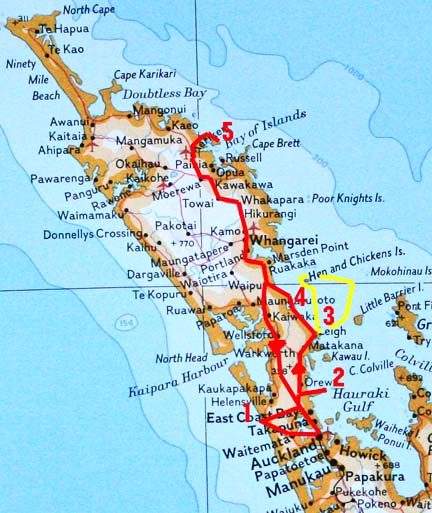 In November 2009, I signed up to do a "Five Grasswrens in Five Days" trip in South Australia [see trip report],
primarily because there were excellent international air bargains at
the time. The best bargain was on Air New Zealand, and all flights to
Australia stopped in Auckland. It seemed a perfect opportunity to stop
in New Zealand for a few days and do a pelagic trip. Rita and I had
been to North Island, New Zealand, around Christmas 1997, and seen a
good variety of endemics, so this was also a chance to return to some
of those spots, but this time with a digital camera!
In November 2009, I signed up to do a "Five Grasswrens in Five Days" trip in South Australia [see trip report],
primarily because there were excellent international air bargains at
the time. The best bargain was on Air New Zealand, and all flights to
Australia stopped in Auckland. It seemed a perfect opportunity to stop
in New Zealand for a few days and do a pelagic trip. Rita and I had
been to North Island, New Zealand, around Christmas 1997, and seen a
good variety of endemics, so this was also a chance to return to some
of those spots, but this time with a digital camera!
My visit was just for five days [12-16 Nov 2009], so I limited myself to a few specific locales in "Northland" of North Island. They are shown on the map with this legend:
- Muriwai gannet colony
- Tiritiri Matangi Island, off the Whangaparaoa Peninsula [see separate page]
- Pelagic trip in Haurake Gulf; route in yellow [see separate page]
- Pakiri Beach
- Kiwi search out of Kerikeri
Two of those targeted locales have separate pages; highlights of the remainder are shown and discussed below. Although it was the austral spring, the weather was cool, often overcast, and sometimes rainy.
Photo (above) western coast of North Island, from Muriwai
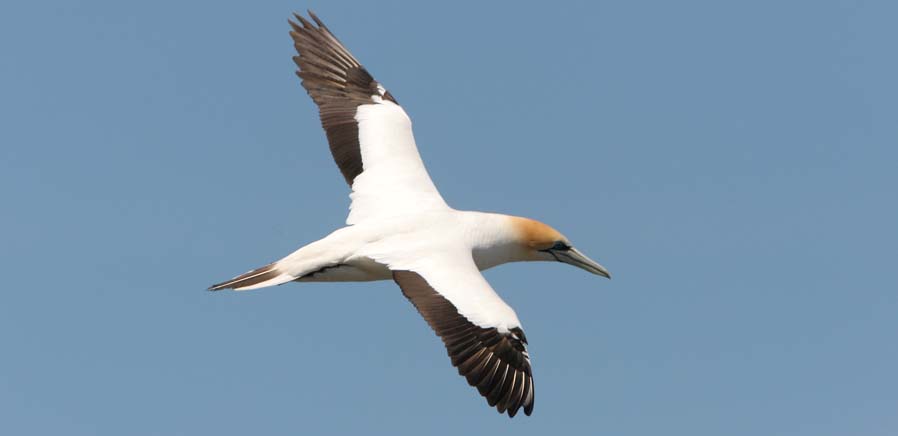
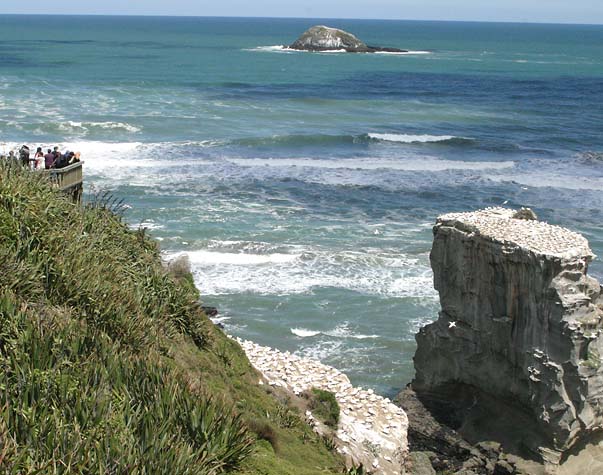 At Muriwai, less than an hour north of Auckland on the western coast, is coastal gannetry that is now a major tourist attraction. One has many opportunities to have close and prolonged views of Australian Gannet
(above). Up to 1200 pairs breed here from August to March. The main
colonies, both on a oceanic stack and on the cliff, can be studied from
fine viewpoints (upper left in the photo, left).
At Muriwai, less than an hour north of Auckland on the western coast, is coastal gannetry that is now a major tourist attraction. One has many opportunities to have close and prolonged views of Australian Gannet
(above). Up to 1200 pairs breed here from August to March. The main
colonies, both on a oceanic stack and on the cliff, can be studied from
fine viewpoints (upper left in the photo, left).
During my visit in mid-November, the birds were on eggs or had just-hatched young. The colonies are very noisy with the constant comings and goings, and the frequent squabbles over territory (below). I was among dozens of photographers having a field day shooting at flying, sleeping, and preening gannets.
There is a smaller colony of White-fronted Terns (~100 pairs) adjacent to the mainland gannetry.
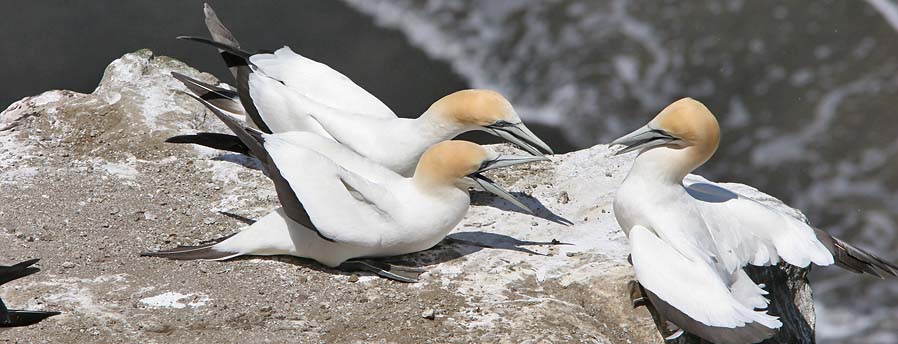
See separate pages for these locales: |
|

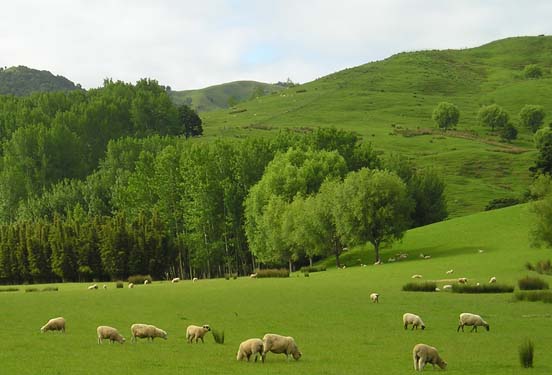 After
my visit to Tiritiri Matangi on 13 Nov, and the pelagic trip on Haurake
Gulf on 14 Nov, I headed up the 'inside' coast, enjoying a lovely drive
through sheep-raising countryside (right). The road winded along the
shore, giving many views of bays and offshore islets. At Pakiri Beach
(above) there is a lovely white sand beach, perfect for strolling in
bare feet, even on an overcast day. This is good because one must time
a visit to low tide, and wade a calf-deep river mouth, to reach the
north side of the beach. There, during the nesting season, a reserve is
fenced off for rare shore birds, guarded by a warden, but one can view
the species from its perimeter.
After
my visit to Tiritiri Matangi on 13 Nov, and the pelagic trip on Haurake
Gulf on 14 Nov, I headed up the 'inside' coast, enjoying a lovely drive
through sheep-raising countryside (right). The road winded along the
shore, giving many views of bays and offshore islets. At Pakiri Beach
(above) there is a lovely white sand beach, perfect for strolling in
bare feet, even on an overcast day. This is good because one must time
a visit to low tide, and wade a calf-deep river mouth, to reach the
north side of the beach. There, during the nesting season, a reserve is
fenced off for rare shore birds, guarded by a warden, but one can view
the species from its perimeter.
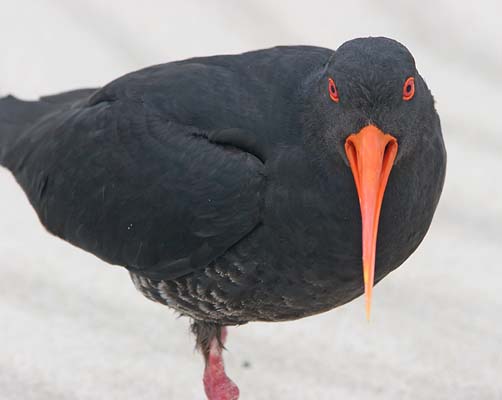
Species of interest include Variable Oystercatcher (left; this one challenged me near a nest in the dunes, away from the reserve), and the endangered Fairy Tern (below left) and Red-breasted Dotterel (below right), both of which nest inside the fenced area. Only one pair of Fairy Tern use this site, as the species is very aggressive and will not tolerate another pair anywhere nearby. Loafing on the beach just up from the waves were flocks of White-fronted Tern (second row below).
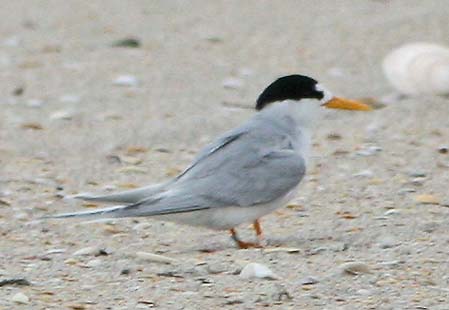 |
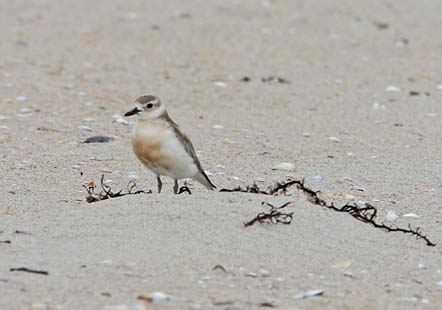 |

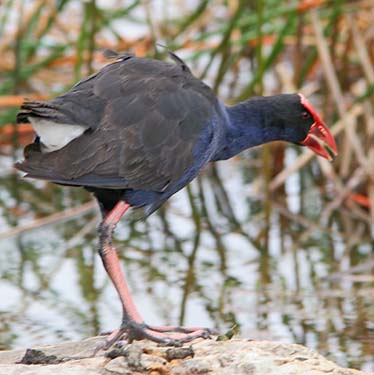 My final destination was Kerikeri, far to the north. There were more birds enroute, including Purple Swamphen in wetlands (left; here at Waro Lake), and widespread species such as Sacred Kingfisher (below left). One realized its true distribution once the distinctive call was learned.
My final destination was Kerikeri, far to the north. There were more birds enroute, including Purple Swamphen in wetlands (left; here at Waro Lake), and widespread species such as Sacred Kingfisher (below left). One realized its true distribution once the distinctive call was learned.
I also checked patches of remnant forest, and there New Zealand Fantail (below right) was often present. The largest such patch as called Manginangina Reserve, which includes a part of the much larger Puketi Forest, and is northwest of Kerikeri. It is a reserve that Rita and I visited way back in 1997, when we had special permission to search for Kokako, but we couldn't find any. Today, there are no Kokako left in that forest, but there are plans to attempt re-introductions in the future.
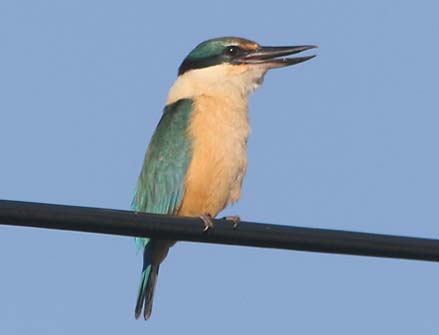 |
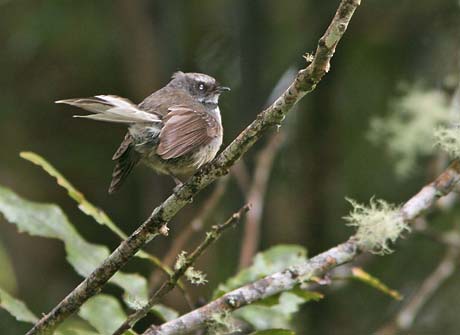 |
At Kerikeri, I had booked a night at "Birders' Rest" B&B, operated by Carol & Detlef Davies (near right). The accommodations were excellent, and I also signed up for a effort to see a North Island Kiwi after dark. In the late afternoon I visited Manginangina Reserve, about 20 km to the northwest, where one could walk among giant Kaori trees on a lovely boardwalk (far right). Kaori trees are ancient conifers found in the far East, and isolated islands such as New Zealand and New Caledonia. |
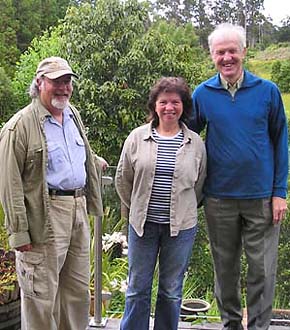 |
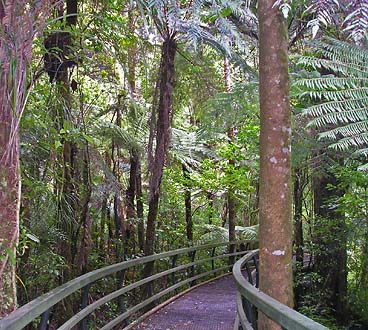 |
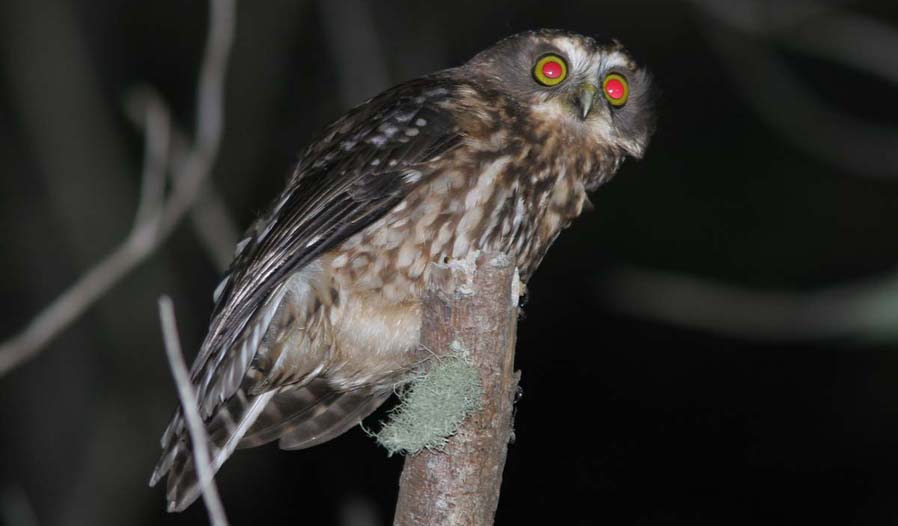
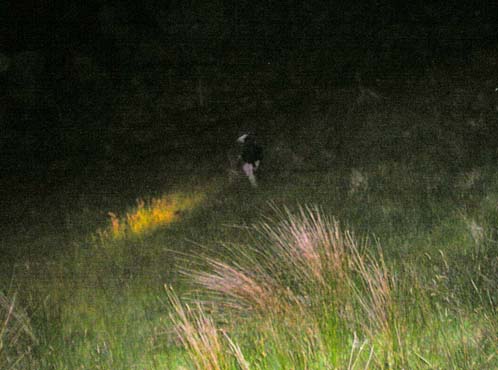 Our night-time effort for kiwi began with an unexpected and amazing view of Morepork
owl (above). Then Detlef & Carol led us (two clients from the U.K.
and me) down a grassy slope, through upland and swales, to a wet
meadow. We could hear kiwis calling in the distance. Here our guides,
using their red-filtered torches, found two females feeding in the tall
grass. One of them was particularly focused on probing the wet ground
with her bill, and it allowed Carol to walk right up (left). Carol was
even able to reach out and touch to kiwi before it moved off. My shots
(two photos just below) were taken from the rear.
Our night-time effort for kiwi began with an unexpected and amazing view of Morepork
owl (above). Then Detlef & Carol led us (two clients from the U.K.
and me) down a grassy slope, through upland and swales, to a wet
meadow. We could hear kiwis calling in the distance. Here our guides,
using their red-filtered torches, found two females feeding in the tall
grass. One of them was particularly focused on probing the wet ground
with her bill, and it allowed Carol to walk right up (left). Carol was
even able to reach out and touch to kiwi before it moved off. My shots
(two photos just below) were taken from the rear.
Later, on our way back up the hill, we encountered a large male that took off running. I was able to get ahead of it, and got a shot as he ran past (second row below).
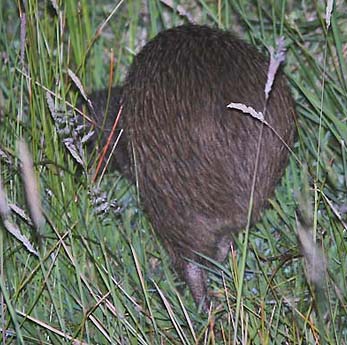 |
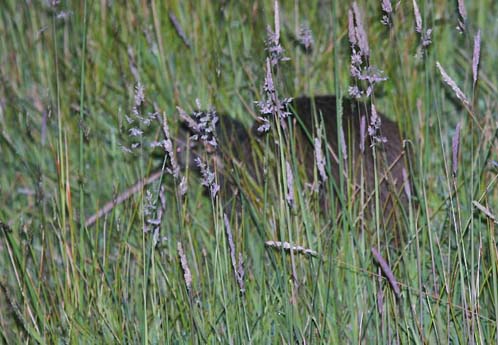 |
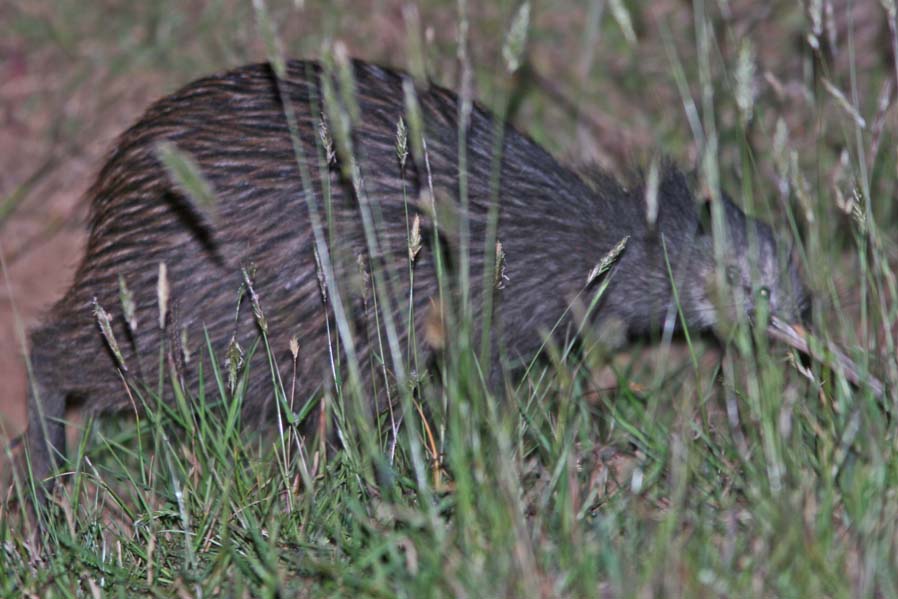
page created 12-15 Dec 2009
|
© Don Roberson 2009 |